
by Terri Cook Monday, June 23, 2014
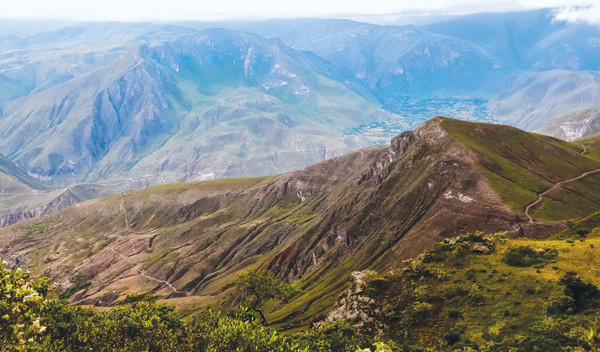
Located approximately 2,800 meters high on a plateau in the Andes, Peru's petrified forest is exposed around the rim of a caldera-like basin. To the east and south of the basin, the Rio Chancay has sliced a deep canyon. Credit: Jean Schnell.
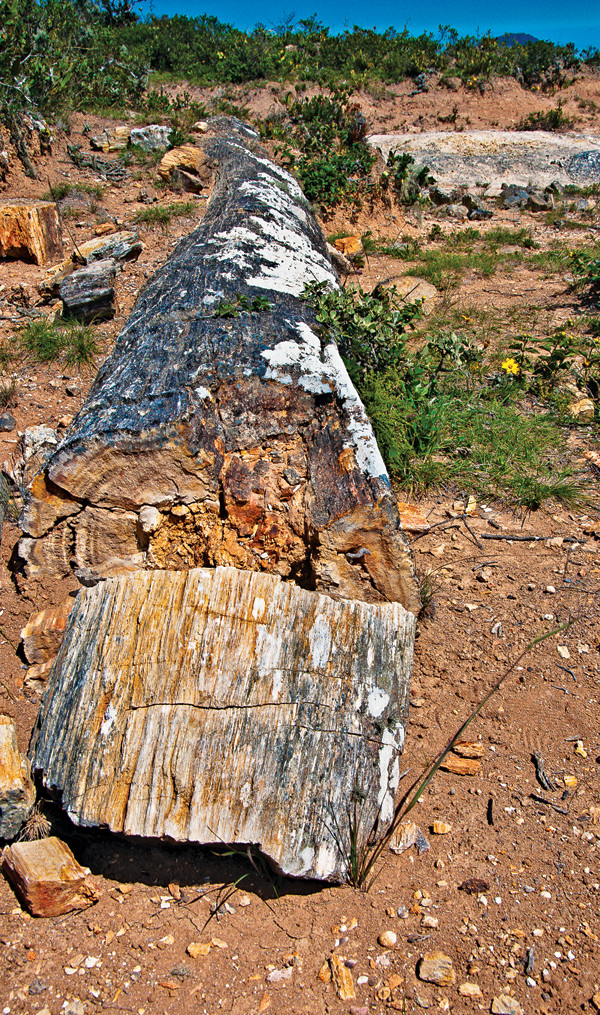
This log was lithified — preserving the rings and details of the tree's anatomy — 39 million years ago. Credit: Jean Schnell.
Tucked high in the Andes Mountains of northern Peru is a remarkable fossil locality: a 39-million-year-old petrified forest preserved in nearly pristine condition. With its existence unknown to scientists until the early 1990s — and its significance unbeknownst to villagers — this ancient forest hosts the remains of more than 40 types of trees, some still rooted, that flourished in a lowland tropical forest until they were suddenly buried by a volcanic eruption and a series of roiling torrents of mud and debris known as lahars.
These fossils provide an unusually detailed record of neotropical vegetation and climate during the Eocene, a period in Earth’s history when the highest temperatures were about 10 degrees Celsius warmer than today. Such preservation is rare in the New World tropics, as is the close association, anywhere in the rock record, of petrified wood with fossilized leaves.
Since its discovery, scientists and other concerned citizens from Peru to Colorado have been working to study and preserve the spectacular site, now known as El Bosque Petrificado Piedra Chamana, and its unusual and diverse fossils.
Located at approximately 2,800 meters elevation on the Pacific slope of the rugged Andes Mountains, Peru’s petrified forest is exposed around the rim of a basin in which the remote village of Sexi (pronounced like “sexy”; population 450) is nestled amid the grandeur of the Cordillera Occidental of the Andes. The village’s name stems from the native Quechua word “Secci,” meaning “flower of the swamp” — possibly a figurative tribute to the village’s beautiful setting or a reference to a certain plant found in wet areas. To the east and south of the basin, the Rio Chancay has sliced a gorge as deep as the Grand Canyon not far from peaks towering more than 4,000 meters tall.
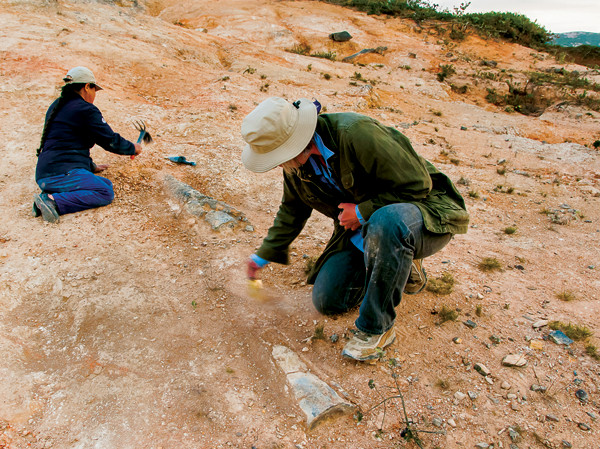
Deborah Woodcock (right) and an assistant, Elba Davila, work to uncover stone logs at the petrified forest. Credit: Jean Schnell.
The views of this canyon from the petrified forest are stunning, says Herb Meyer, park paleontologist for Colorado’s Florissant Fossil Beds National Monument. “You are standing among Eocene fossil trees along the rim of the canyon and looking across gorgeous mountain views and down into the depths of the canyon. It’s one of the most scenic settings for a fossil site anywhere in the world.”
In the early 1990s, a Peruvian college student studying economic development in Sexi became fascinated with the unusual stones located within the village’s territorial limits. When he took a few specimens to the Museum of Natural History in Lima, the research staff — geologist Guillermo Morales and biologist Isabel Prado Velazco — quickly identified them as plant fossils and recognized their scientific importance.
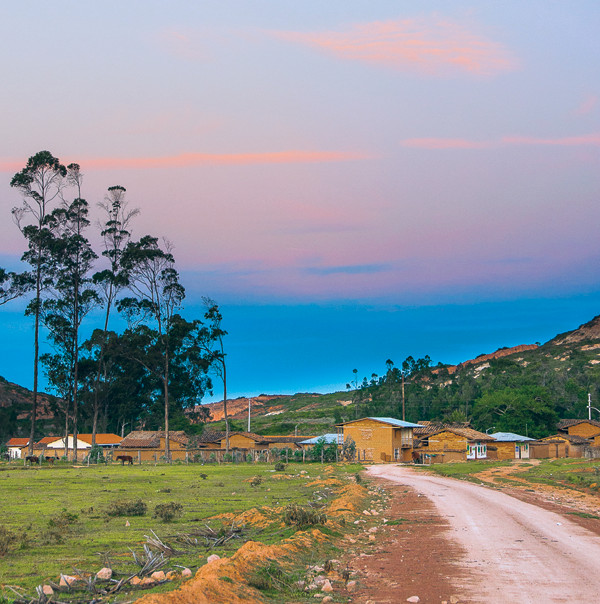
The petrified forest is exposed around the Andean village of Sexi, a town of 450 people. Credit: Jean Schnell.
In 1997, Morales heard that paleoclimatologist Deborah Woodcock, now a research scientist at Clark University’s Marsh Institute in Massachusetts whose research focuses on the use of fossilized wood as a climate proxy, was in Peru as a Fulbright Scholar. He invited her on one of the first scientific expeditions to see the petrified forest.
Woodcock vividly remembers her first trip there. “We drove up from the coast on very bad roads to a wild and wonderful place,” she recalls. “At the site, there was fossil wood everywhere. I had never seen anything like it.”
Villagers didn’t think much about the fossil wood, says Santiago Asenjo Davila, an accountant in Lima who grew up in Sexi. A self-described promoter of Sexi’s fossilized forest, Asenjo Davila fondly remembers stretching out and napping on the logs as a child. Chunks of petrified wood were regularly used by villagers as seats and even as curbstones along the town’s dirt streets. “We didn’t know they were so old; we didn’t have that sense of amazement,” Asenjo Davila says.
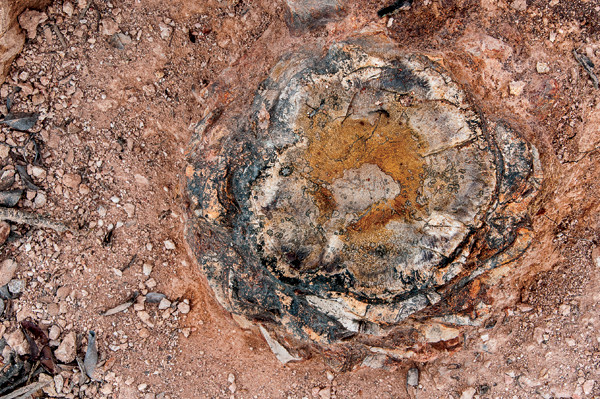
Looking down on a fossilized palm tree trunk. Credit: Jean Schnell.
Following her initial visit to the Piedra Chamana in 1997, Woodcock started assembling a team of scientists to study the site and its fossils. She also began pondering the best way to manage the site and protect the fossil resources, she says.
One of her first calls was to Meyer, who has the rather uncommon expertise of managing a fossil forest site. The two scientists teamed up, eventually obtaining funding from the American Philosophical Society and the National Science Foundation to study the forest’s geologic and taphonomic context.
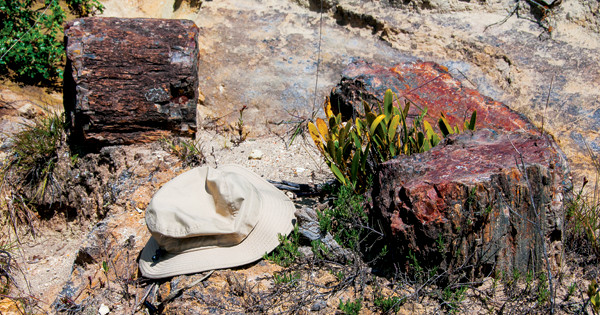
The trees indicate that the site was originally near sea level and far warmer than it is now. Credit: Jean Schnell.
Woodcock, Meyer and their team began by studying Sexi’s rocks, which are part of the Calipuy Group, a thick sequence of vo between about 53 million and 14 million years ago. Fieldwork done in conjunction with volcanologists Nelia Dunbar and Bill McIntosh of New Mexico Tech showed that the petrified wood occurs in the middle of this formation in three layers: a thin ash layer overlain by two lahar deposits. The petrified wood is most plentiful in the ash and lower lahar and can be seen embedded in these horizons as well as in weathered-out chunks scattered on the ground.
To determine the age of the fossils, McIntosh and colleagues at the New Mexico Geochronology Research Laboratory at New Mexico Tech dated plagioclase crystals from the ash deposit. Argon dating revealed an age of 39.35 plus or minus 0.21 million years old. This was a period of considerable scientific interest 16 million years after the maximum temperatures at the Paleocene-Eocene boundary and 5 million to 6 million years before the big global cooling at the Eocene-Oligocene boundary — all prior to the uplift of the modern Andes.
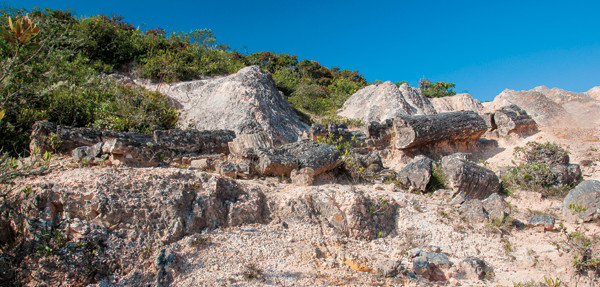
Palo Tendido, the largest fossilized tree at the site, is 10 meters long and has a diameter of 0.75 meters. Credit: Jean Schnell.
The researchers then turned their attention to studying the Piedra Chamana fossils and their ability to shed light on the site’s climate during the Eocene. After identifying about 40 types of fossil wood and more than 20 kinds of leaf fossils there, the researchers happened upon a surprising discovery: the presence of mangrove fossils in the petrified forest. Today, these plants are limited to coastal areas, so Woodcock concludes that the Piedra Chamana forest must also have grown near sea level. Given the site’s current 2,800-meter elevation, this discovery implies that the area has been uplifted to its current elevation since the Middle Eocene, providing a strong constraint on the region’s uplift history.
Collectively the team’s research paints a vivid picture of what the Piedra Chamana forest once looked like. “If you strolled through this forest 39 million years ago,” Woodcock says, “you would have seen extensive areas of mangroves along the coastline. There would have been small trees along the watercourses. Further inland there would have been a more diverse forest with large emergent trees, lianas [climbing plants], and scattered palms.” It might have resembled the vegetation seen today in areas like Colombia’s Caribbean coast, she says.
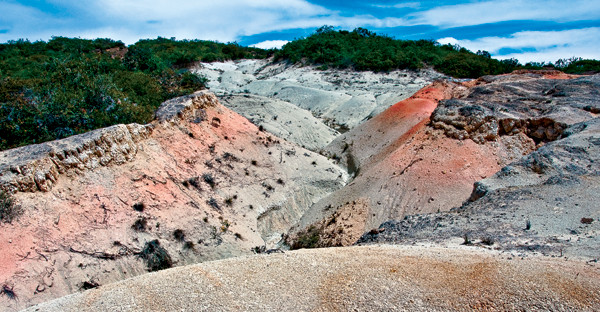
The rocks at Piedra Chamana are part of the Calipuy Group, a thick sequence of volcanics emplaced between about 53 million and 14 million years ago. The main fossil-bearing layers date to about 39 million years ago. Credit: Jean Schnell.
Another tool Meyer turned to was the fossil leaves themselves: One method for understanding climate involves looking at whether the leaves have “teeth,” or serrations, around their margins. Today, he says, higher proportions of species having leaves with teeth occur in cooler climates, and smooth-margined leaves are more abundant in warmer climates. “I have yet to find a toothed leaf at Sexi,” Meyer says. “This is an indication that the Eocene climate there was very warm indeed.”
Based on these results, the researchers have concluded that the vegetation was characteristic of a dry tropical forest with seasonal rainfall. “However, some anatomical features of the woods are anomalous relative to modern tropical forests,” Woodcock says, “and may indicate that the climate differed from today’s in certain ways. It might have varied in temperature — we know that this was a very warm period — or perhaps something related to the seasonality of water demand.”
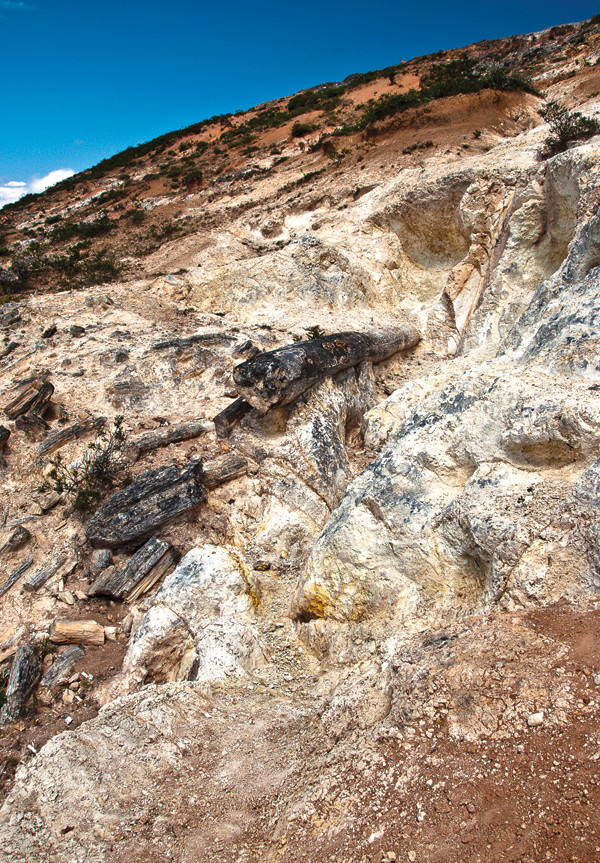
Fossilized tree trunks at Piedra Chamana. Lahars uprooted trees and carried them along as the dense flows surged down the mountain. The preserved remains look much like the deposits left by the lahars at Mount St. Helens. Credit: Jean Schnell.
Another area of active study has been reconstructing the series of events that preserved the Piedra Chamana forest. According to Diana Pajuelo Aparicio, a geologist at INGEMMET, the Institute for Geology, Mining, and Metallurgy (Peru’s equivalent of the U.S. Geological Survey), who is part of a team mapping the volcanic rocks around Sexi, the volcano responsible for burying the forest was most likely a stratovolcano located 16 to 20 kilometers to the north.
Streams of ash periodically flowed from this vent, and occasionally its flanks collapsed, sending lahars roaring down the valleys. Such eruptions deposited a 150-meter-thick layer of volcanic rock in what is now the area around Sexi. Afteme then elapsed for a thin, greenish-red paleosol — an ancient soil horizon — to develop. The presence of leaf fragments, including palm fronds, and vertically oriented trees with bases and even some roots extending into the paleosol indicates that this is the horizon in which the Piedra Chamana forest thrived.
When the northern volcano belched out another eruptive cloud, ash rained down on the landscape, stripping leaves from the trees, blanketing the forest floor with a meter-thick layer of white ash, and preserving the forest as it grew.
The presence of abundant accretionary lapilli — small, fragile, rounded balls of volcanic ash that form around a wet nucleus falling through an ash cloud — reported by Woodcock, Meyer and colleagues in Geological Society of America’s GSA Bulletin in 2009 suggests that rain began to fall during the eruption. Precipitation likely added enough water to mobilize the first of two lahars. This dense flow of rain-soaked ash snapped off many trees as it surged through the area, uprooting other vegetation that was quickly encased in the 3-meter-thick deposit. Today, this is the main wood-bearing horizon.
Woodcock and Meyer compare the ancient forest’s destruction to the aftermath of the infamous 1980 eruption of Mount St. Helens in Washington, where lahars floated large logs on the surface while simultaneously transporting fragile lapilli clasts.
A second ancient lahar then occurred, after which the entombing volcanic deposits shielded much of the buried vegetation from decay. Over time, silica-rich groundwater percolated through the buried vegetation, where the trees’ organic content altered the local chemical environment, allowing silica to precipitate. Over time, silica filled every tree cell, slowly turning the stumps into solid stone.
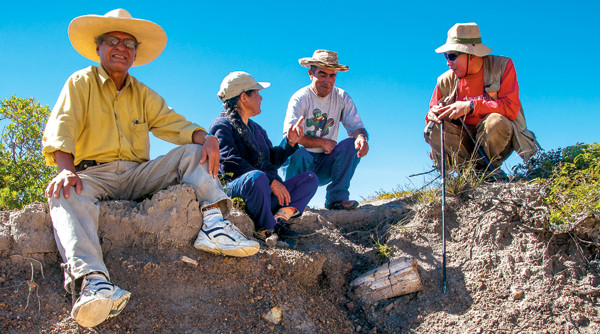
Part of the research and conservation team at Piedra Chamana. Left to right: Santiago Asenjo Davila, an accountant living in Lima who grew up in Sexi and is involved in the preservation efforts; Elba Davila, Deborah Woodcock's field assistant; a local guide; and Pedro Navarro, a Peruvian geologist. Credit: Jean Schnell.
In the time since the Piedra Chamana forest was entombed 39 million years ago, the landscape has changed dramatically. Considerable uplift has occurred, with multiple lines of evidence pointing to the greatest uplift occurring in the last 10 million years. Faulting that accompanied the uplift helped bring the fossils — which cover a half-square-kilometer area bounded to the north and south by faults — toward the surface, where erosion took over. Over millions of years, many of these fossils were exposed, where the villagers at Sexi could see them.
The discovery of Peru’s petrified forest is especially significant because the Piedra Chamana fossils are one of the first diverse assemblages of fossil wood from the tropics to be described, according to Woodcock. “The site at Sexi is very important because it fills a gap in our understanding about Eocene forests and climate in South America,” Meyer adds.
Woodcock and Meyer say that the scientific significance of the Piedra Chamana Petrified Forest makes preservation of the site and its fossils a pressing matter. In 1997, the Peruvian government designated the fossils for protection as a “Patrimony of the Nation” site, meaning it is now considered part of the nation’s cultural heritage.
The legal designation, however, has not resulted in much on-the-ground protection and has actually been a source of local frustration. “In Peru, there are many fabulous places like Machu Picchu that are also Patrimony of the Nation,” Woodcock says. “So when that designation was enacted for Sexi, I think people had high expectations that things would happen just because of it.”
One concern expressed by everyone involved is the potential for theft of the petrified wood, especially at the main site, which is close to a road. “The people don’t have much consciousness of the importance of it,” says Asenjo Davila, who has encouraged the authorities to do more to protect the forest. “The way it is, the town sits in the bottom of a basin, and people try to keep their eyes on it, but it’s a big area,” he explains.
Few visitors have traveled to Sexi, but as more begin to arrive, the theft of fossils could become similar to that in Arizona’s Petrified Forest National Park, where there are no pieces of “pocket-size” fossilized wood left close to the trails, Meyer says. “It’s a balance between people coming to the site to see it and then having things disappear. We want to instill a sense in the local people that this can become sustainable geotourism with benefits to the economy of the village for many years to come, as long as they focus on conservation, education and science as the real values,” he says.
The Sexi villagers should benefit from the discovery of this significant fossil site, according to Woodcock and Meyer. Villagers have been very helpful from the beginning, Woodcock says — in both scientific and conservation efforts. It would be good to develop the site at least a little to help preserve the fossils and to help the Sexi villagers, she says.

The Friends of the Florissant Fossil Beds group in Colorado helped supsit to Florissant by Santiago Asenjo Davila and Diana Pajuelo Aparicio, where they met with Herb Meyer and others to learn about ways of caring for important fossil sites and collections. Credit: Terri Cook.
Recently there have been promising steps in the site’s development, Meyer says. The U.S. National Park Service has supported Meyer’s technical assistance to the site, including the development of a descriptive brochure. Meyer, Woodcock, researchers from INGEMMET, and colleagues from the Museum of Natural History in Lima are collaborating on guidebooks for visitors to the site, and the nonprofit Friends of the Florissant Fossil Beds group in Colorado has established an international partnership to support its nonprofit counterpart in Sexi. “It’s a part of the [U.S.] National Park Service’s mission to extend the benefits of conservation throughout the world, not just in the United States,” Meyer notes.
While visiting the site in 2005 with an intern, Meyer prepared a complete site inventory and conservation report. In addition, through one of their grants, Woodcock and Meyer helped get a small adobe museum built on the site, and they prepared educational panels in both Spanish and English for the museum walls. “With help from another intern in 2011,” Meyer says, “we’ve also put together an informative website that our Friends group hosts” at peru.fossilbeds.org.
The Friends of the Florissant Fossil Beds group also collects donations specifically directed to help to protect and develop the Piedra Chamana site. In addition, the Friends helped support a recent visit to Florissant by Asenjo Davila and INGEMMET’s Pajuelo Aparicio, which “gave them the opportunity to see the variety of ways that we have in the U.S. for taking care of our important fossil sites and collections and using these resources to promote research and public understanding about Earth’s past,” Meyer says.
During the Peruvians’ visit, Woodcock, Meyer and many others eagerly shared ideas they hoped the Peruvians could implement to increase conservation awareness, education and visitation at Sexi. The park’s maintenance staff, for example, showed them how to construct trails so that a GPS route already traced by Woodcock and Meyer can be developed into an interpretive trail. Other priorities include fencing off sections of scientific interest, improving the access roads, developing more museum exhibits, and possibly opening a small guesthouse, according to Woodcock.
As development slowly proceeds, Woodcock, Meyer and other colleagues are still working on science at the site. Further research on the paleosol and the characteristics of the substrate associated with the fossils promises to yield more information about the paleoenvironment of the fossil forest. “Scientists will be coming here for many years to come,” Woodcock says. “And we hope that other people will come as well to see the fossils and one of the world’s most beautiful fossil localities.”
© 2008-2021. All rights reserved. Any copying, redistribution or retransmission of any of the contents of this service without the expressed written permission of the American Geosciences Institute is expressly prohibited. Click here for all copyright requests.